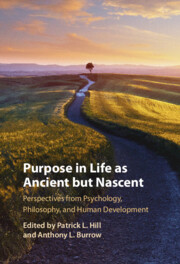 Purpose In Life As Ancient but Nascent
Purpose In Life As Ancient but Nascent Book contents
- Purpose in Life as Ancient but Nascent
- Purpose in Life as Ancient but Nascent
- Copyright page
- Contents
- Figures
- Tables
- Contributors
- Chapter 1 Purpose as an Ancient yet Nascent Construct
- Chapter 2 The Moral Purpose of Wisdom
- Chapter 3 Is Purpose Findable?
- Chapter 4 The Affluence–Purpose Paradox
- Chapter 5 Positive Transitions to Adulthood
- Chapter 6 Undergraduate Students’ Purpose and Persistence in Higher Education
- Chapter 7 How Institutions of Higher Education Support and Thwart Students’ Negotiations of Identity and Self-Direction
- Chapter 8 How to Cultivate Sense of Purpose and Life Engagement
- Chapter 9 You Live, You Learn
- Chapter 10 Seizing the Power of Religion to Shape Purpose
- Chapter 11 Religious Faith and Life Purpose
- Chapter 12 Where Does Purpose Belong in Well-Being Theory?
- Chapter 13 Self-Compassion and Ikigai
- Chapter 14 Purpose as a Timeless Pursuit
- Index
- References
Chapter 10 - Seizing the Power of Religion to Shape Purpose
Published online by Cambridge University Press: 31 October 2025
- Purpose in Life as Ancient but Nascent
- Purpose in Life as Ancient but Nascent
- Copyright page
- Contents
- Figures
- Tables
- Contributors
- Chapter 1 Purpose as an Ancient yet Nascent Construct
- Chapter 2 The Moral Purpose of Wisdom
- Chapter 3 Is Purpose Findable?
- Chapter 4 The Affluence–Purpose Paradox
- Chapter 5 Positive Transitions to Adulthood
- Chapter 6 Undergraduate Students’ Purpose and Persistence in Higher Education
- Chapter 7 How Institutions of Higher Education Support and Thwart Students’ Negotiations of Identity and Self-Direction
- Chapter 8 How to Cultivate Sense of Purpose and Life Engagement
- Chapter 9 You Live, You Learn
- Chapter 10 Seizing the Power of Religion to Shape Purpose
- Chapter 11 Religious Faith and Life Purpose
- Chapter 12 Where Does Purpose Belong in Well-Being Theory?
- Chapter 13 Self-Compassion and Ikigai
- Chapter 14 Purpose as a Timeless Pursuit
- Index
- References
Summary
Religious beliefs are a profound source of motivation and purpose for many people. This is especially true of fundamentalists of different faiths, who strive to strictly adhere to what they believe to be scriptural guidance for how to live their lives. However, given the high rates of religious illiteracy across American citizens, belief in a religion does not necessarily indicate knowledge of the contents of one’s religious teachings. Perhaps as a consequence, people belonging to the same religion, and the clergy who guide them, have used different aspects of the scriptures to express divergent viewpoints (for and against slavery, homophobia, violence, etc.). The complexity of religious scriptures and interpretations across history has meant that members of religions who have sought to follow the righteous path have, at times, been taught that expressing bias against certain groups is the virtuous thing to do. As such, religion has been used to justify strategic beliefs (based on power and political motives) which then become fused with religious identity in private beliefs and public discourse. This chapter addresses how the noble purpose associated with being a virtuous person can be reclaimed from the forces that exploit the power of religion to create division and discord. We call on people to educate themselves about the content and context of various religious scriptures, to value diversity and avoid bias, and to cultivate spiritual and intellectual humility.
Information
- Type
- Chapter
- Information
- Purpose In Life As Ancient but NascentPerspectives from Psychology, Philosophy, and Human Development, pp. 207 - 227Publisher: Cambridge University PressPrint publication year: 2025
References
Accessibility standard: WCAG 2.2 AAA
Why this information is here
This section outlines the accessibility features of this content - including support for screen readers, full keyboard navigation and high-contrast display options. This may not be relevant for you.Accessibility Information
Content Navigation
Allows you to navigate directly to chapters, sections, or non‐text items through a linked table of contents, reducing the need for extensive scrolling.
Provides an interactive index, letting you go straight to where a term or subject appears in the text without manual searching.
Reading Order & Textual Equivalents
You will encounter all content (including footnotes, captions, etc.) in a clear, sequential flow, making it easier to follow with assistive tools like screen readers.
You get concise descriptions (for images, charts, or media clips), ensuring you do not miss crucial information when visual or audio elements are not accessible.
You get more than just short alt text: you have comprehensive text equivalents, transcripts, captions, or audio descriptions for substantial non‐text content, which is especially helpful for complex visuals or multimedia.
You can access graphs or charts in a text or tabular format, so you are not excluded if you cannot process visual displays.
Visual Accessibility
You will still understand key ideas or prompts without relying solely on colour, which is especially helpful if you have colour vision deficiencies.
You benefit from high‐contrast text, which improves legibility if you have low vision or if you are reading in less‐than‐ideal lighting conditions.